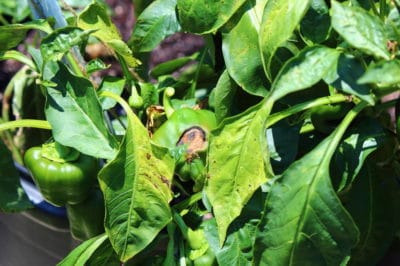Disease
Disease is caused by various microorganism living in the soil that infect plant tissues. The plant will exhibit symptoms which will help you diagnose what the disease is and how to treat it. Common diseases found in bell pepper plants include:
- Leaf Spot: Yellow, brown, or black spots on leaves that form lesions and fall off.
- Stem Rot: Stem of seedlings or older plants rots and the plant falls over
- Southern Blight: Black spots on leaves and stem, foliage yellows and dies
- Powdery Mildew: A white powdery fungus that affects wet foliage
Most of these diseases are caused by moisture coupled with warm temperatures and poor airflow. Give pepper plants plenty of space and trim lower branches to increase air circulation near the soil.
Make sure plants are potted in well-draining soil. If there is pooling on the top of the soil after a watering, it needs amending. Amend with sand, coconut coir, organic matter, or compost until the soil soaks in water readily.
Pests
Preventing pests from building up in the garden is the best way to protect your plants from damage. Create a biodiverse ecosystem that attracts predatory insects and birds. These animals feed on problem-causing beetles and aphids.
Aphids are a common bell pepper pest. These tiny green beetles cause foliage to curl and deform before stunting the plant’s growth altogether. lacewing flies, ladybugs, and praying mantises are all excellent control for aphids in the garden and these insects are available commercially.
If you come out one day to find your seedlings chopped off at ground level, it’s likely due to cutworms. These grey grubs live in the soil around the base of your plant and come out at night to eat the delicate young stems. Cutworm collars can be made from household supplies to keep them off of growing plants. Organic insecticide made with dish soap is another option for controlling cutworm damage.
Growing Issues
Pepper plants exposed to temperatures outside their preferred range of between 60-75°F (15-23°C) tend to stunt or drop developing blossoms. Check seed packets for individual varieties and temperature ranges.
Over or under watering tends to cause growth issues in pepper plants. Stick to a regular watering schedule and always adjust for natural precipitation. The most important factors in growing healthy peppers are temperature, damp soil not wet soil, and establishing beneficial companions nearby.
